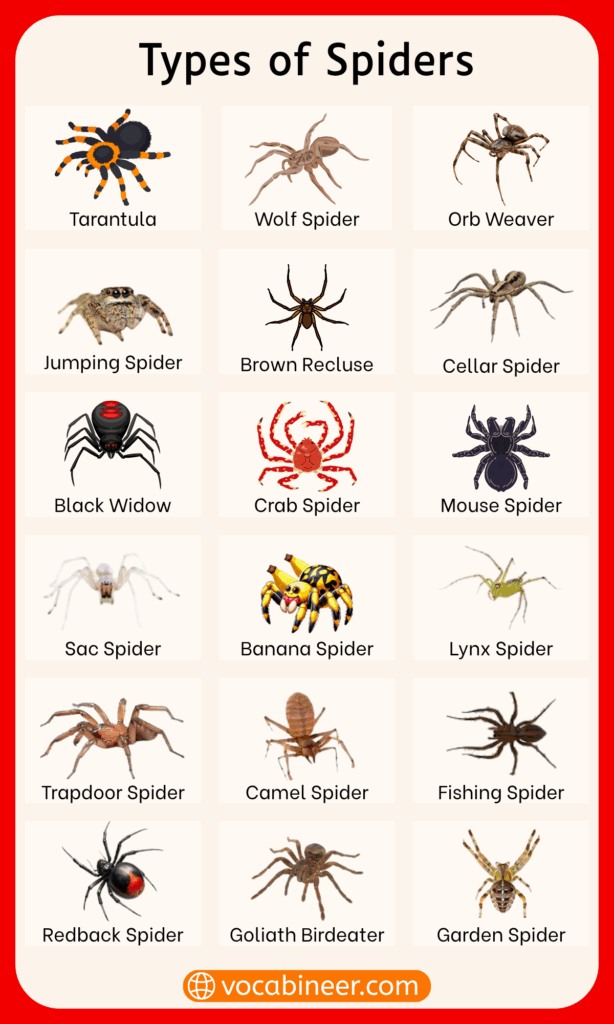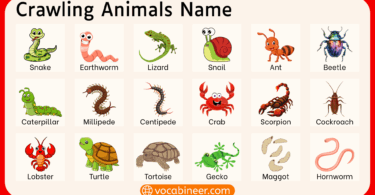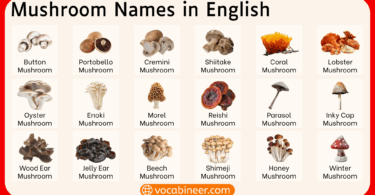Spiders are eight-legged creatures with many different shapes, colors, and names. Learning the types of spiders and their names with pictures helps people tell them apart based on how they look and where they live. From jumping spiders to web builders, each kind has special traits that make them interesting to know. This post helps learners understand spider names and types in English. You’ll also learn to talk about them in science, nature talks, and while reading or watching content with spiders.
In This Page
Different Types of Spiders and Their Names in English
There are many kinds of spiders in the world. They live in different places, behave in unique ways, and look very different from one another. Below is a list of spider types and names in English.
Common Spiders Found in Homes
These spiders often live inside houses or around corners, ceilings, or basements.
House Spider: Found in corners of rooms, they build messy webs and eat flying bugs.
Cellar Spider: Long legs and small bodies, often called daddy long legs, found in basements.
Daddy Long Legs: Not a true spider but often grouped with them, thin legs and small bodies.
Jumping Spider: Small and fast with big eyes, known for jumping and hunting without webs.
Brown Recluse: Hides in dark spots, has venom, and a violin-shaped mark on its back.
Famous Spider Types by Appearance
Some spiders are known for their looks or color patterns, making them easy to spot.
Black Widow Spider: Shiny black with a red hourglass shape under its body, very venomous.
Redback Spider: Looks like the black widow but with a red stripe on its back.
Spiny Orb-Weaver: Small spider with colorful spikes on its back, found in gardens.
Peacock Spider: Tiny, bright-colored spider that dances to attract mates.
Golden Silk Orb-Weaver: Spins yellow webs, large with long legs, found in warm places.

Types of Web-Building Spiders Names
These spiders make webs to catch prey, and their web types are different too.
Orb-Weaver Spider: Makes round, neat webs and is common in gardens and fields.
Cobweb Spider: Makes messy webs in house corners or garages.
Funnel-Web Spider: Spins tunnel-like webs and hides at the end to catch prey.
Bowl and Doily Spider: Builds a bowl-shaped web over a flat sheet to trap bugs.
Ground-Dwelling Spiders List
These spiders live on or near the ground and often hide in burrows or cracks.
Wolf Spider: Large eyes, hunts on the ground without a web.
Trapdoor Spider: Builds a hidden door in the ground to jump out and grab prey.
Tarantula: Big, hairy spider that lives in burrows and moves slowly.
Mouse Spider: Found in Australia, with strong jaws and can be venomous.
Giant House Spider: Very fast and large, often seen running on walls or floors.
Tree and Plant-Dwelling Spiders
These spiders live on leaves, plants, and trees and often blend with nature.
Green Lynx Spider: Bright green and sits on flowers or leaves to wait for prey.
Garden Spider: Often seen in garden webs, with a big round body and yellow patterns.
Leaf-Curling Spider: Hides inside a curled leaf in its web for protection.
Long-Jawed Orb-Weaver: Has long front legs and builds angled webs in bushes.
Types of Jumping Spiders
These spiders don’t build webs for catching food but leap to catch insects.
Regal Jumping Spider: Black with white spots and big eyes, very fast and alert.
Bold Jumping Spider: Hairy, black spider with green jaws and daring movements.
Zebra Jumping Spider: Small with black and white stripes, jumps between walls or plants.
Venomous Spiders and Their Names
Some spiders have venom that can be harmful to people, but most are shy and bite only when touched.
Brown Recluse Spider: Quiet, hides during the day, venom causes skin damage.
Black Widow Spider: Strong venom but rarely bites unless pressed or handled.
Sydney Funnel-Web Spider: Found in Australia, very venomous and aggressive when disturbed.
Six-Eyed Sand Spider: Lives in deserts, covers itself with sand and has powerful venom.
Large and Hairy Spider Types
These spiders are big, hairy, and often look scary, but many are not dangerous to people.
Goliath Birdeater: World’s biggest spider by size and weight, found in South America.
Chilean Rose Tarantula: Calm spider with pinkish hairs, often kept as a pet.
Brazilian Wandering Spider: Fast, active spider with venom, known for wandering at night.
Names of Spiders Known for Unique Behavior
These spiders have special tricks or hunting ways that make them different.
Diving Bell Spider: Lives underwater using air bubbles trapped in a web.
Ogre-Faced Spider: Has big eyes and throws silk nets to trap insects.
Net-Casting Spider: Holds a net between its legs and lunges forward to catch bugs.
Spider Types by Habitat
Spiders are found in all environments. These groups are named for the places they live.
Desert Spiders: Adapted to hot, dry places; hide under sand or rocks.
Forest Spiders: Found on trees, bark, and forest floors, often well-camouflaged.
Water Spiders: Like the diving bell spider, they stay close to or under water.
Cave Spiders: Live in dark caves, often pale with long legs to move in small spaces.
Spider Types Used in Studies and Science
Some spiders are common in labs or studied because of their silk, behavior, or body design.
Common Lab Spider: Used in science for studying webs, eyes, or movement.
Parson Spider: Quick ground spider that often ends up in labs due to its speed.
Spider Monkey Orb-Weaver: Studied for behavior, named for its movement, not related to monkeys.
FAQs about Types of Spiders
The common house spider is usually a Parasteatoda tepidariorum, found in corners or ceilings. It builds messy cobwebs and eats small insects.
Black widow, brown recluse, and Sydney funnel-web spiders have venom that can harm humans, but bites are rare and avoidable.
No, daddy long legs are not true spiders. They’re closer to harvestmen, and they don’t spin webs or have venom.
Orb-weavers make round webs, funnel-web spiders make tunnel shapes, and cobweb spiders make messy, sticky webs in corners.
The Goliath birdeater is the largest spider by weight and size. It lives in South America and has hairy legs.
Read More




